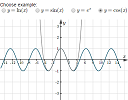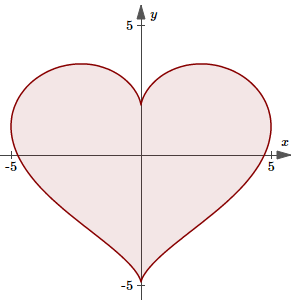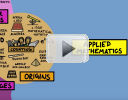IntMath Newsletter: Series interactives, Valentine’s heart
By Murray Bourne, 14 Feb 2017
14 Feb 2017
In this Newsletter:
1. Taylor, Maclaurin & Binary Series interactive applets
2. Math art: Valentine's heart
3. Math in the news
4. Math movie: Map of Mathematics
5. Math puzzles
6. Final thought: Essential fluids
1. Taylor, Maclaurin & Binary Series interactive applets
 |
I recently added some new applets that help you explore approximations to various trigonometric and logarithmic functions using infinite series. |
These series expansions were incredibly useful when they were first developed by Newton, Taylor and Maclaurin in the 17th and 18th centuries, for their many uses in evaluating function values and in calculus.
Here's some background information so you know what's going on in the above applets:
Taylor Series and Maclaurin Series
2. Math art: Valentine's heart
Yes, it's that time of year again.
There are several ways to draw mathematical hearts. I quite like this one because it uses parametric equations, which are easier to deal with than implicit functions.

Mathematical Valentine's heart
x = 5 sin3(t),
y = 4 cos(t) − 1.3 cos(2t) − 0.6 cos(3t) − 0.2 cos(4t)
It's even simpler when you use polar equations.
You can see more parametric curves involving trigonometric functions here: Lissajous Figures
Happy Valentine's!
3. Math in the news
Here's some interesting recent stories involving math.
1. Lethal dose of caffeine given to students in university experiment
The court was told about a catalogue of errors that led to the overdose, which included the calculation being done on a mobile phone, the decimal point being put in the wrong place and there being no risk assessment for the test.
2. Taking graphics cards beyond gaming
The NVIDIA GPU (graphics processing unit) in your computer is making it possible to solve "systems of multiple simultaneous equations involving thousands to millions of variables" by making use of better and cheaper energy efficiency rather than memory.
3. Random numbers discovery improves climate simulations
"Small-scale ocean currents are fiendishly difficult to recreate in models, but we found that random numbers do a good job of standing in for them. This approach leads to significant improvements in our climate modelling abilities."
[Hat-tip to PiPo for the above stories.]
4. Math movie: Map of Mathematics
 |
A lot of people form a narrow view of mathematics from their school experiences. This Map of Mathematics video by Dominic Walliman attempts to give a broad outline of the different fields of math. |
Here's a still image of the complete map (440 kB)
And here's a huge version that's clearer (770 kB)
By Dominic's own admission, there are 3 errors in the map. Can you spot them?
5. Math puzzles
The puzzle in the last IntMath Newsletter asked about the number of terms in a geometric sequence.
Correct answers with sufficient explanation were provided by Adeyemi, Aksel, Tomas, Don, and Eamon. (Honourable mention to Gerard who was very close.)
New math puzzle: Box
A square piece of metal is made into an open box by cutting a square with side s from each corner and turning up the sides. If the volume of the resulting box is v cm3, what are the dimensions of the original sheet of metal?
Bonus: If we needed to make a closed box out of the same piece of metal, what would its maximum volume be?
You can leave your responses here.
6. Final thought: Essential fluids
When I was in northern India recently, visibility on each smoggy morning was often only a few meters. I was reminded of what ocean explorer Jacques Cousteau once said:
Water and air, the two essential fluids on which all life depends, have become global garbage cans. [Jacques Yves Cousteau]
Until next time, enjoy whatever you learn.
See the 11 Comments below.
14 Feb 2017 at 6:10 pm [Comment permalink]
I have the following puzzle:
X + 1/x = 5
Solve for: (-b+/- SQR(25 - 4))/2 = (5+/-SQR 21)/2
X**2 + 1/X**2 = ? And ?????
Then I did :
X*X + 1/X * X = 5*X
X**2 + 1 -5*X = 0
14 Feb 2017 at 7:57 pm [Comment permalink]
I'm sorry, Dave. I'm afraid I can't do that.
Something messed up. :-(